How Indians View Gender Roles in Families and Society – Pew Research Center
Learn our analysis on: TikTok | Podcasts | Election 2024
Learn our analysis on: TikTok | Podcasts | Election 2024
This examine is a part of Pew Analysis Middle’s most complete, in-depth exploration of India so far. For this report, we surveyed 29,999 Indian adults (together with 22,975 Hindus, 3,336 Muslims, 1,782 Sikhs, 1,011 Christians, 719 Buddhists, 109 Jains and 67 respondents who belong to a different faith or are religiously unaffiliated). Many findings from the survey in India had been beforehand revealed in “Religion in India: Tolerance and Segregation,” which appeared intimately at spiritual and nationwide id, spiritual beliefs and practices, and attitudes amongst spiritual communities. The survey additionally included a number of questions on gender roles in Indian society, however these questions weren’t analyzed within the earlier report and at the moment are being revealed for the primary time. Interviews for this nationally consultant survey had been performed face-to-face underneath the course of RTI Worldwide from Nov. 17, 2019, to March 23, 2020.
To enhance respondent comprehension of survey questions and to make sure all questions had been culturally applicable, the Middle adopted a multiphase questionnaire development process that included professional evaluation, focus teams, cognitive interviews, a pretest and a regional pilot survey earlier than the nationwide survey. The questionnaire was developed in English and translated into 16 languages, independently verified by skilled linguists with native proficiency in regional dialects.
Respondents had been chosen utilizing a probability-based pattern design that may enable for sturdy evaluation of all main spiritual teams in India – Hindus, Muslims, Christians, Sikhs, Buddhists and Jains – in addition to all main regional zones. Knowledge was weighted to account for the completely different chances of choice amongst respondents, and to align with demographic benchmarks for the Indian grownup inhabitants from the 2011 census. The survey is calculated to have coated 98% of Indians ages 18 and older and had an 86% nationwide response price.
For extra data, see the Methodology for this report. The questions used on this evaluation can be found here.
Greater than half a century in the past, India was one of many first international locations on the planet to elect a woman as prime minister, and the nation presently has a number of extremely influential ladies politicians, together with Sonia Gandhi, the pinnacle of one of many major national parties. At this time, most Indians say that “ladies and men make equally good political leaders,” and greater than one-in-ten really feel that ladies typically make higher political leaders than males, in accordance with a latest Pew Analysis Middle survey of almost 30,000 adults all through India. Solely 1 / 4 of Indian adults take the place that males make higher political leaders than ladies.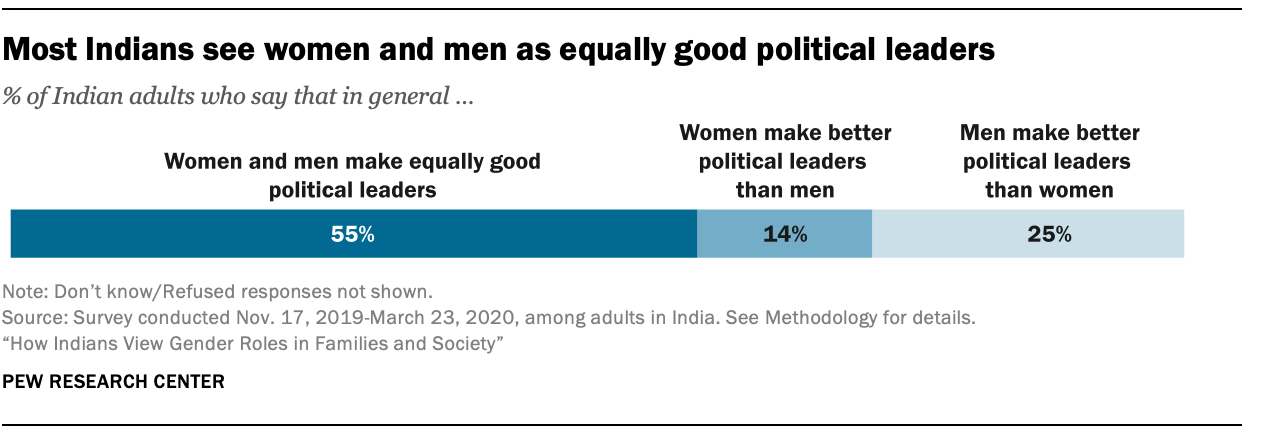
But, in home settings, Indians are inclined to say males ought to have extra outstanding roles than ladies. About nine-in-ten Indians agree with the notion {that a} spouse should at all times obey her husband, together with almost two-thirds who utterly agree with this sentiment. Indian ladies are solely barely much less probably than Indian males to say they utterly agree that wives ought to at all times obey their husbands (61% vs. 67%), in accordance with the survey, which was performed between late 2019 and early 2020 (principally earlier than the COVID-19 pandemic).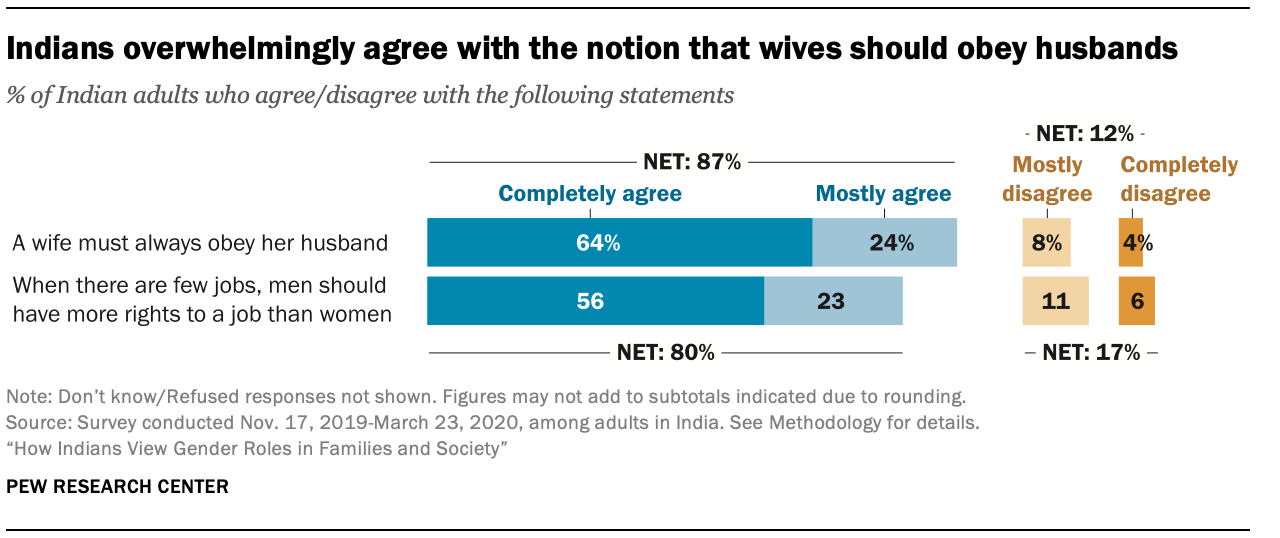
Many Indians categorical egalitarian views towards some gender roles within the residence. As an illustration, 62% of adults say each women and men ought to be liable for caring for youngsters. However conventional gender norms nonetheless maintain sway amongst giant segments of the inhabitants: Roughly a 3rd of adults (34%) really feel that little one care ought to be dealt with primarily by ladies.
Equally, a slim majority (54%) says that each women and men in households ought to be liable for incomes cash, however many Indians (43%) see this as primarily the duty of males. And Indian adults overwhelmingly say that when jobs are briefly provide, males ought to have better rights to employment than ladies, reflecting the continued prominence of males within the financial sphere. Eight-in-ten agree with this sentiment, together with a majority (56%) who utterly agree.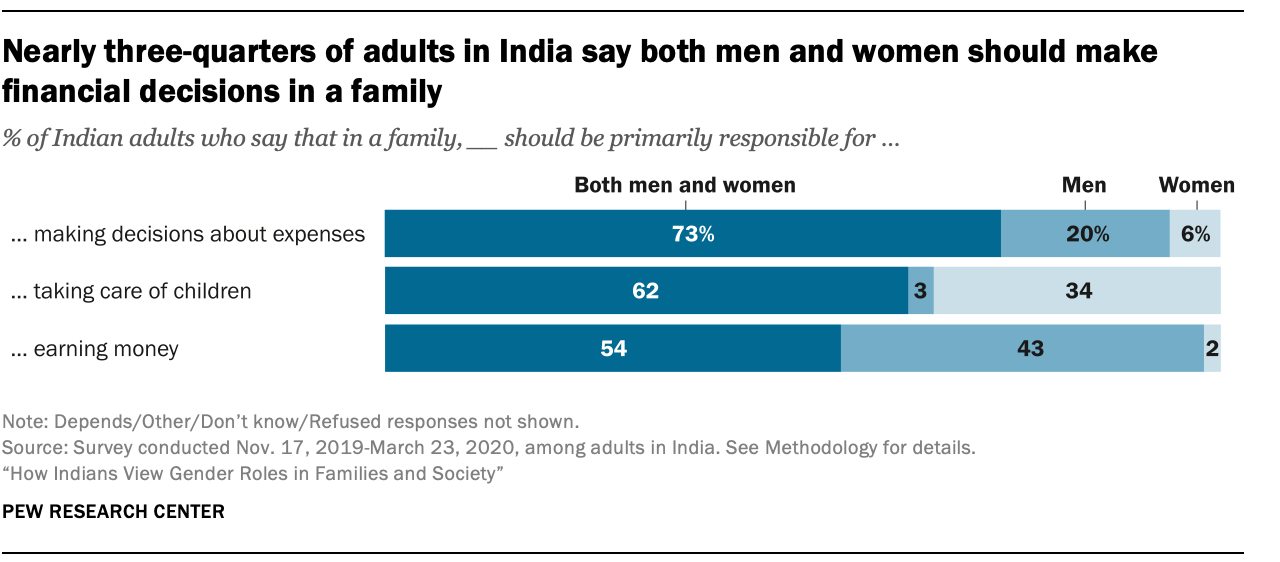
Indians worth having each little kids: Almost all Indians say it is rather necessary for a household to have at the very least one son (94%) and, individually, to have at the very least one daughter (90%). And most Indians say that each little kids ought to have equal rights to inheritance from dad and mom (64%) and have the accountability to care for folks as they age (58%). However survey respondents are way more more likely to say that sons, somewhat than daughters, ought to have better rights and duties in these areas. For instance, whereas about four-in-ten Indian adults say that sons ought to have the first accountability to take care of getting old dad and mom, simply 2% say the identical about daughters.
That is one in a sequence of Pew Analysis Middle reviews on India primarily based on a survey of 29,999 Indian adults performed Nov. 17, 2019, to March 23, 2020, in addition to demographic knowledge from the Indian Census and different authorities sources. Different reviews could be discovered right here:
Furthermore, most Indians (63%) see sons – not daughters – as being primarily liable for dad and mom’ final rites and burial rituals. Spiritual funeral practices for family members are widely seen as very important, and at the very least according to Hindu tradition, sons must perform last rites for a mother or father to make sure freedom for the soul within the afterlife. Just lately, ladies – together with actress Mandira Bedi and the daughters of India’s former Chief of Defense Staff – have publicly challenged these norms by lighting members of the family’ funeral pyres.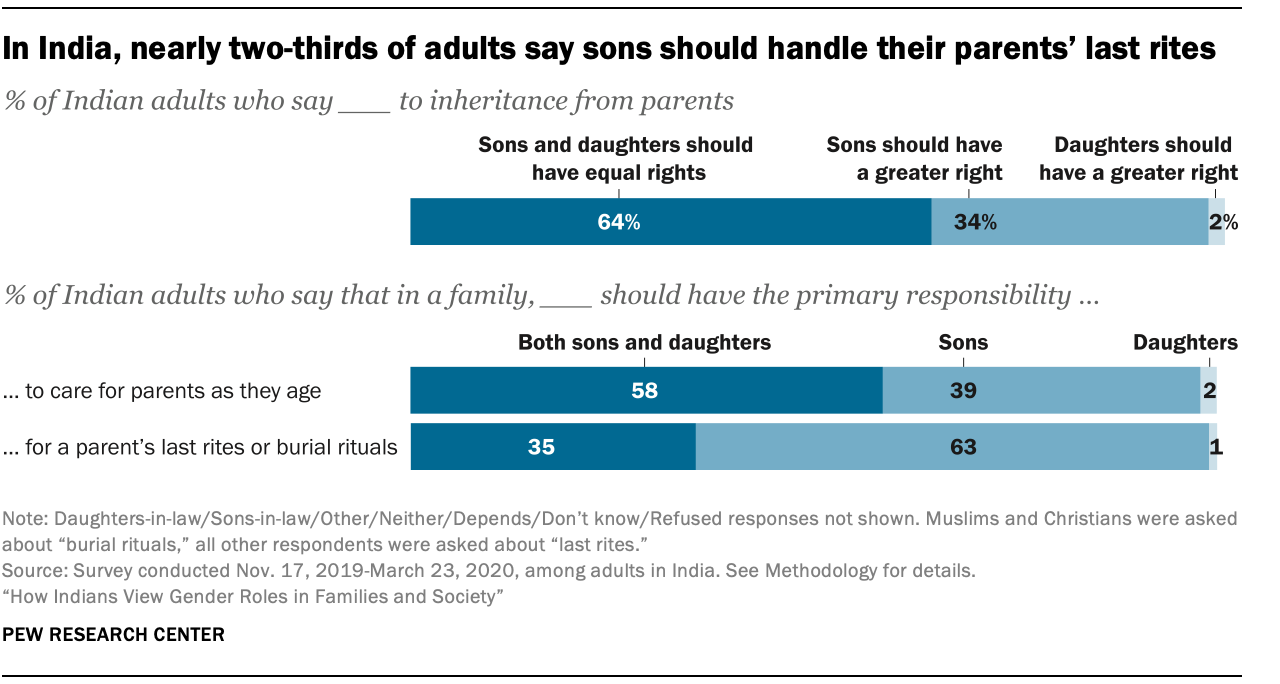
These norms are a part of a wider phenomenon in Indian society the place, for a wide range of historic, social, spiritual and financial causes, households have a tendency to position greater worth on sons somewhat than daughters – a customized broadly known as “son choice.” Grownup sons historically stay with their dad and mom and supply monetary assist to the household. In the meantime, when daughters marry, their households could pay a dowry, an unlawful observe that still features in some marriages, and daughters usually live with their husband’s parents and fulfill obligations towards their in-laws. Lately, Indian society has paid elevated consideration to bettering the standing of daughters – the federal government’s Beti Bachao, Beti Padhao (“Save the lady little one, Educate the lady little one”) program, for instance, seeks to stop sex-selective practices throughout being pregnant and to make sure instructional alternatives for women by conducting public awareness media campaigns, amongst different insurance policies.
Son choice and the elevated availability of ultrasounds in latest a long time have contributed to the selective abortion of feminine fetuses throughout India, regardless of the illegality of the observe. And for a few years, India has had one of many most skewed sex ratios at birth on the planet. For instance, in accordance with the 2011 census, there have been 111 boys born for each 100 ladies born in India, although latest knowledge suggests the hole may be narrowing.1
Many Indians see sex-selective abortion as acceptable in at the very least some circumstances: 4-in-ten Indians say it’s both “utterly acceptable” or “considerably acceptable” to “get a checkup utilizing trendy strategies to stability the variety of ladies and boys within the household,” a euphemism to connote sex-selective abortion.2 An analogous share (42%) says balancing the variety of ladies and boys in a household through trendy strategies is totally unacceptable, whereas roughly one-in-ten describe the observe as “considerably” unacceptable.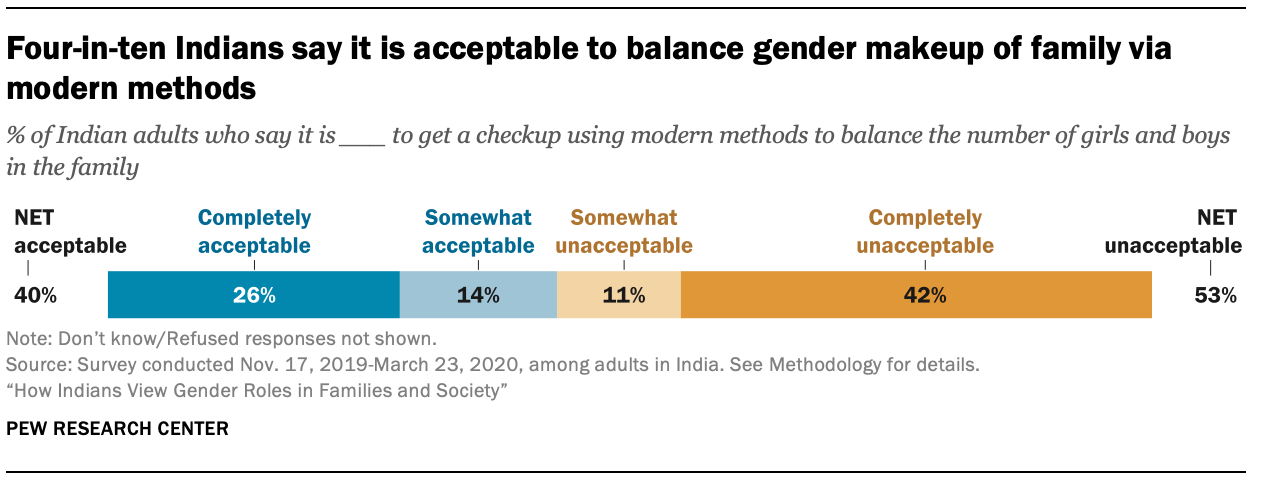
On this query and all others included on this report, variations in opinion between women and men and throughout age teams are modest. In different phrases, Indian ladies usually aren’t more likely than Indian males to precise egalitarian views on son choice and gender roles (see “In India, men a little more likely than women to have conservative views on gender”), and the identical is true of younger Indian adults (ages 18 to 34) relative to their elders.
That is the second report primarily based on a Pew Analysis Middle survey performed face-to-face nationally amongst 29,999 Indian adults. Many findings from the survey had been beforehand revealed in “Religion in India: Tolerance and Segregation,” which appeared intimately at spiritual and nationwide id, spiritual beliefs and practices, and attitudes amongst spiritual communities. The survey additionally included a number of questions on gender roles in Indian society, however these questions weren’t analyzed within the earlier report and at the moment are being revealed for the primary time. (One other latest Pew Analysis Middle report, “Religious Composition of India,” used Indian census knowledge to look at how India’s spiritual make-up has modified since independence.)
Native interviewers administered the survey between Nov. 17, 2019, and March 23, 2020, in 17 languages. The survey coated all states and union territories of India, with the exceptions of Manipur and Sikkim – the place the rapidly-developing COVID-19 scenario prevented fieldwork from beginning within the spring of 2020 – and the distant territories of the Andaman & Nicobar Islands and Lakshadweep; these areas are residence to a couple of quarter of 1% of the Indian inhabitants. The union territory of Jammu and Kashmir was coated by the survey, although no fieldwork was performed within the Kashmir area itself as a result of safety considerations.
This examine, funded by The Pew Charitable Trusts and the John Templeton Basis, is an element of a bigger effort by Pew Analysis Middle to grasp spiritual change and its affect on societies around the globe. The Middle beforehand has performed religion-focused surveys throughout sub-Saharan Africa; the Center East-North Africa area and plenty of different international locations with large Muslim populations; Latin America; Israel; Central and Eastern Europe; Western Europe; and the United States.
The remainder of this Overview covers perceptions of gender discrimination; how Indian attitudes on gender evaluate globally; the sturdy affect of schooling and faith in gender attitudes; the minimal variations in gender attitudes between Indian women and men, and amongst adults of various ages; and regional and state-level variation in how gender roles are considered.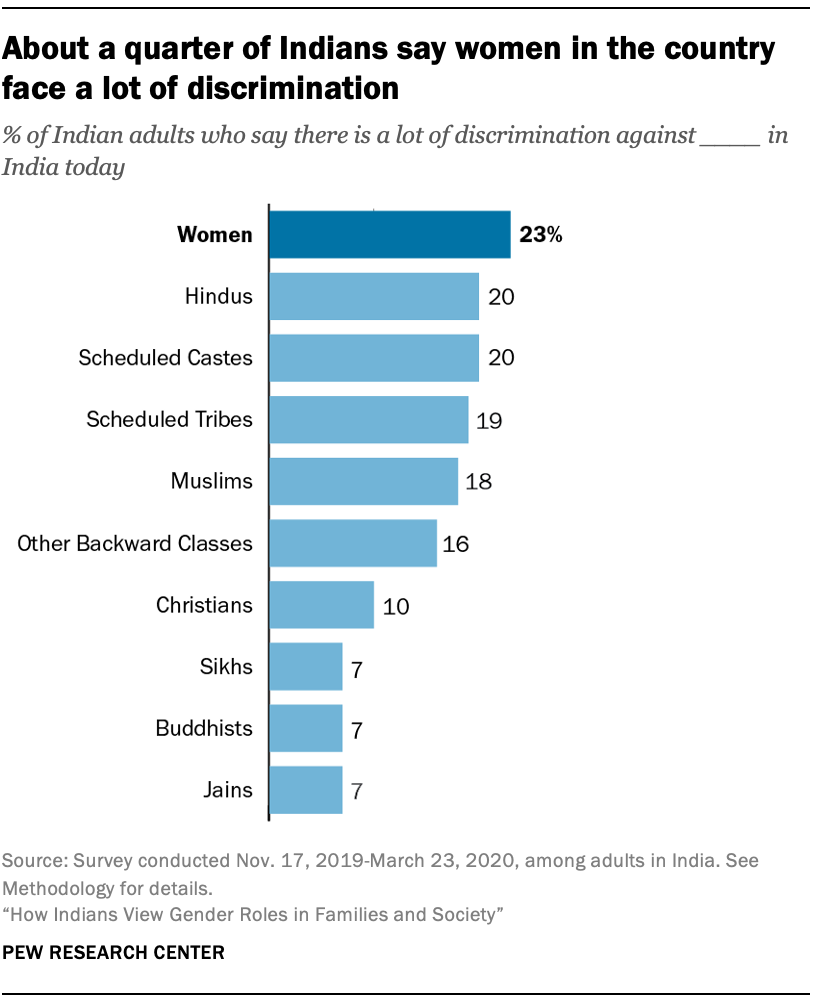 Virtually 1 / 4 of Indians (23%) say there may be “numerous discrimination” in opposition to ladies of their nation, barely greater than the shares who say some religious groups or lower castes face numerous discrimination. Which means the overwhelming majority of Indian adults don’t see numerous discrimination in opposition to any of those teams.
Virtually 1 / 4 of Indians (23%) say there may be “numerous discrimination” in opposition to ladies of their nation, barely greater than the shares who say some religious groups or lower castes face numerous discrimination. Which means the overwhelming majority of Indian adults don’t see numerous discrimination in opposition to any of those teams.
About one-in-six Indian ladies (16%) stated that that they had personally felt discriminated in opposition to as a result of they’re a lady within the final 12 months earlier than the 2019-2020 survey – similar to the shares of girls who stated they’ve lately felt discriminated in opposition to as a result of their faith (16%) or their caste (14%). Comparable shares of Indian males stated that they had confronted latest gender (14%), spiritual (17%) or caste (15%) discrimination.
However way more adults see violence in opposition to ladies as a serious nationwide challenge. As described in a earlier Pew Research Center report, three-quarters of Indians say violence in opposition to ladies is a “very massive drawback” – better than the share who say communal violence is a really massive drawback (65%), and just like the shares who say this about crime and corruption (76% every). Police circumstances registered as “crimes in opposition to ladies” almost doubled between 2010 and 2019, and rapes and murders of girls have led to massive protests across India.
The survey requested respondents which of two choices is extra necessary to enhance the security of girls of their group: educating boys to respect all ladies or educating ladies to behave appropriately. Roughly half of Indians say educating boys to respect ladies is extra necessary, whereas a couple of quarter of Indians say educating ladies to behave appropriately is the higher manner to enhance ladies’s security. A further quarter of Indian adults don’t take a transparent place between these two choices, as a substitute voicing that some mixture of the 2 approaches is important, that improved regulation and order via policing will enhance the scenario or that ladies are already secure. Girls are barely extra probably than males to say that educating boys to respect all ladies is the extra necessary manner to enhance security (53% vs. 48%).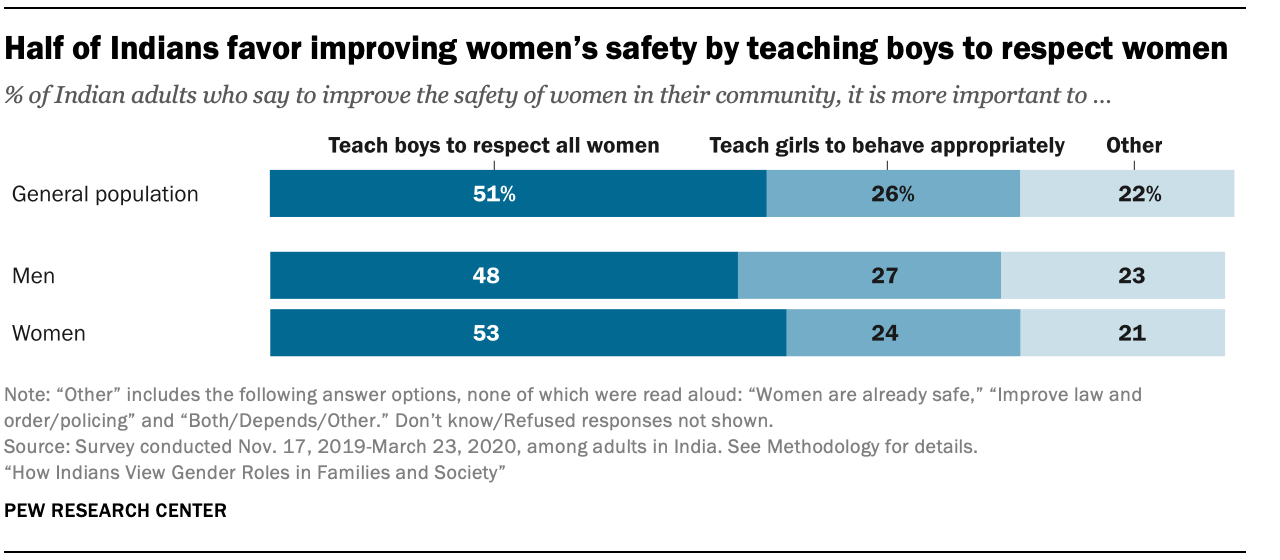
Pew Analysis Middle has requested a few the questions on this survey in lots of international locations around the globe, permitting a glimpse of the place Indians match globally relating to public opinion on these points.
Throughout 47 international locations and territories, a world median of 70% say it is rather necessary for girls to have the identical rights as males, in accordance with knowledge from two recent waves of the Middle’s Global Attitudes survey. That is just like the share of Indians who really feel gender equality is essential (72%).3
Indians are much less probably than folks in North America (92% median), Western Europe (90%) and Latin America (82%) to position excessive significance on ladies and men having the identical rights. However they’re extra probably than these dwelling in sub-Saharan Africa (48% median) and the Center East-North Africa area (44%) to say this. Adults in Central and Japanese Europe (69% median) are roughly just like Indians on this query.
Inside South Asia, Indians are considerably extra probably than Pakistanis to say it is rather necessary for women and men to have equal rights (72% vs. 64%).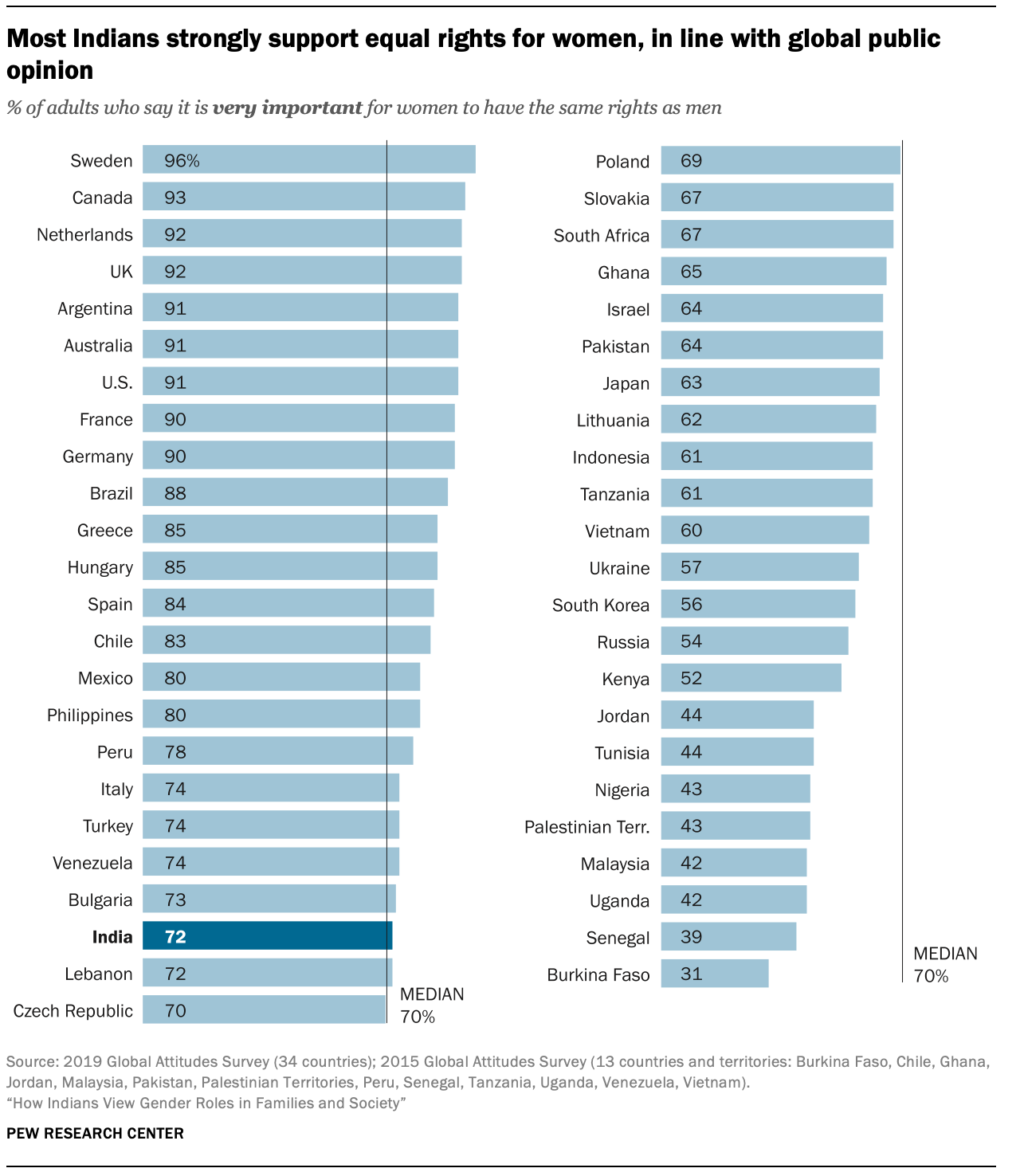
Regardless of broadly aligning with world public opinion on equal rights for girls, Indians are usually extra conservative than folks in most different international locations surveyed relating to gender dynamics within the residence and within the financial system.
As an illustration, throughout 61 international locations surveyed from 2013 to 2019, a median of 17% utterly agree with the assertion “When jobs are scarce, males ought to have extra rights to a job than ladies,” however roughly 3 times as many Indians say the identical (55%).4 In truth, just one surveyed nation – Tunisia (64%) – has the next share who utterly agree with the notion that males ought to have better rights to jobs in occasions of excessive unemployment.
On this measure, Indians are considerably extra conventional than folks from North America (4% median), Western Europe (7%), Central and Eastern Europe (14%) and Latin America (20%).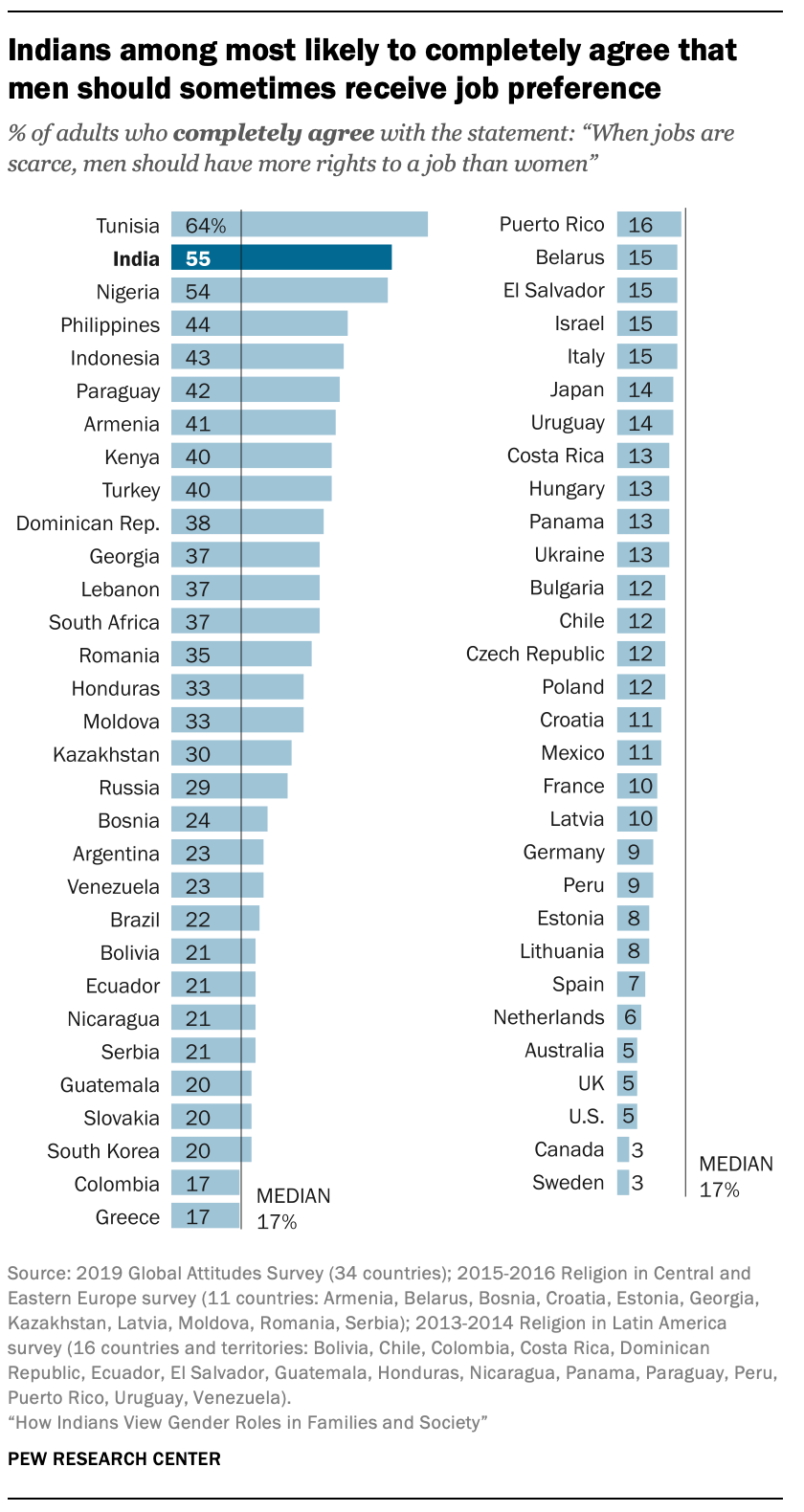
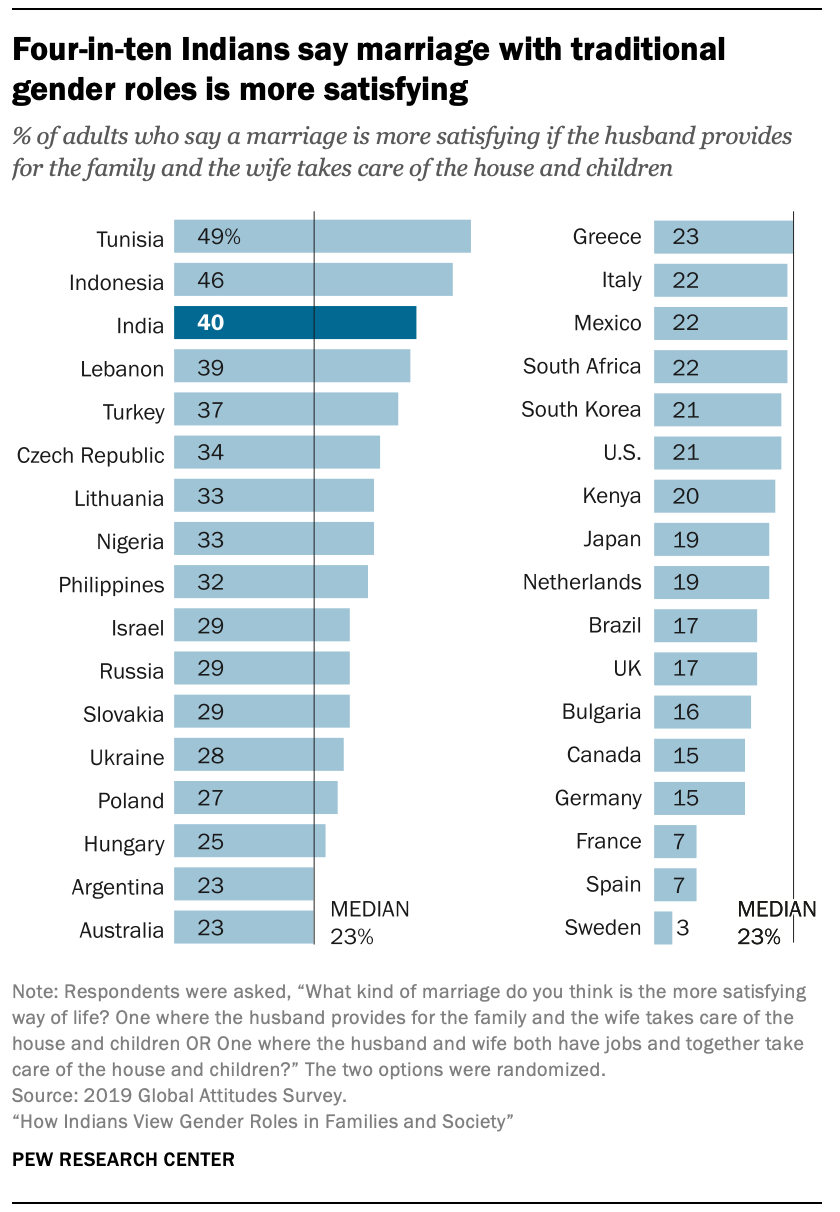 These attitudes, combined with a scarcity of jobs, could also be one motive why India has one of many lowest feminine labor pressure participation charges on the planet (21% vs. 53% world median), in accordance with 2019 United Nations (UN) data. India’s male labor pressure participation price is far greater (76%), and this within-country discrepancy contributes to India’s low rating on the UN Gender Inequality Index (123rd out of 162 ranked international locations).
These attitudes, combined with a scarcity of jobs, could also be one motive why India has one of many lowest feminine labor pressure participation charges on the planet (21% vs. 53% world median), in accordance with 2019 United Nations (UN) data. India’s male labor pressure participation price is far greater (76%), and this within-country discrepancy contributes to India’s low rating on the UN Gender Inequality Index (123rd out of 162 ranked international locations).
The 2019 Global Attitudes survey in 34 international locations additionally requested a query about gender roles that was not on the 2019-2020 India survey: “Which form of marriage is extra satisfying, one the place the husband offers for the household and the spouse takes care of the home and youngsters, or one the place the husband and spouse each have jobs and collectively maintain the home and youngsters?”
Indians are among the many more than likely to say the husband ought to present for the household whereas the spouse focuses on the house: 4-in-ten Indians desire this conventional household dynamic, in contrast with a world median of 23%.
Indian adults with a university diploma are much less probably than these with out a school schooling to assist conservative gender norms. For instance, a couple of quarter of college-educated Indians (24%) say ladies in a household ought to be primarily liable for caring for youngsters, whereas roughly a 3rd of Indians with much less formal schooling (35%) say little one care accountability ought to relaxation with ladies.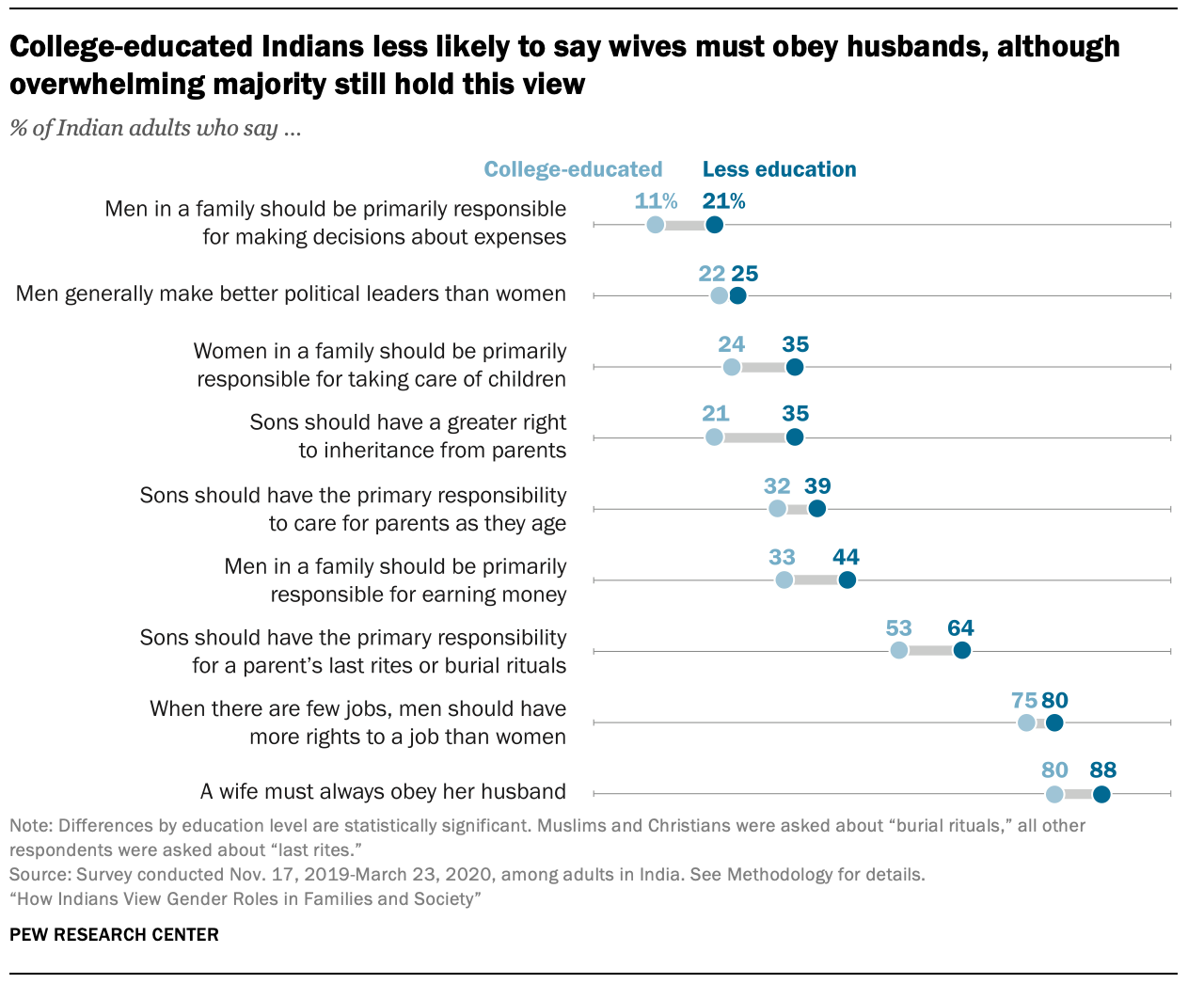
Nevertheless, even Indians who’ve accomplished school typically do overwhelmingly endorse conventional views on gender-related points. As an illustration, giant majorities amongst these with a university diploma (80%) and people with much less schooling (88%) agree with the notion that wives should at all times obey their husbands.
India’s essential spiritual teams have extensively divergent opinions about gender roles within the household. For instance, whereas almost three-quarters of Indian Muslims (74%) say that sons ought to have the first accountability for a mother or father’s burial rituals, simply 29% of Sikhs say that sons alone ought to deal with final rites. Throughout a number of facets of household life, this sample repeats: Muslims are the more than likely, and Sikhs are the least probably, to assist conventional gender roles.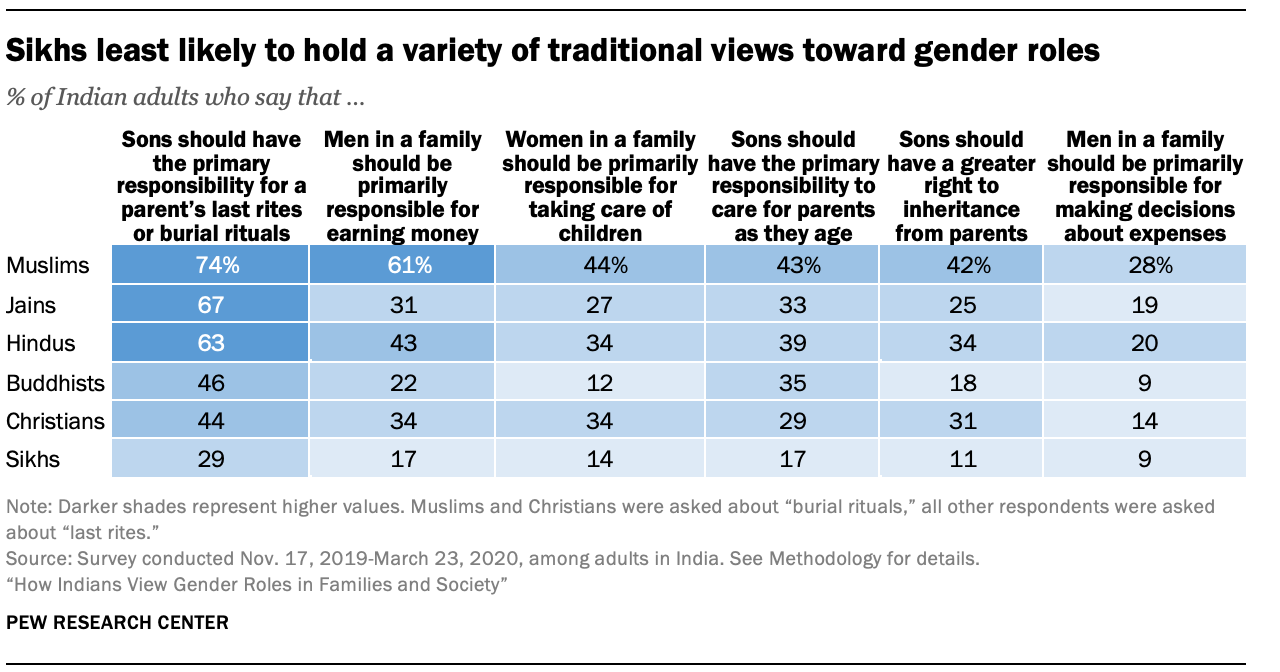
Muslims are considerably much less probably than Sikhs to have a university schooling (5% vs. 9%), primarily based on the 2011 census, and as famous beforehand, Indians with out a school diploma usually tend to maintain conservative gender attitudes. However even when contemplating schooling, Muslims are way more probably than Sikhs to assist conventional gender roles within the household. As an illustration, a couple of third of college-educated Muslims (32%) say ladies ought to be primarily liable for caring for youngsters, whereas solely about one-in-ten college-educated Sikhs (9%) share this view.
The overwhelming majority of India’s Sikh group lives within the state of Punjab (India’s solely majority-Sikh state), and other people in Punjab constantly categorical much less choice for conventional gender roles inside the residence – a sample that isn’t simply pushed by Sikhs within the state. Certainly, Punjabi Hindus are a lot much less probably than Hindus nationally to precise conventional views on some gender roles. For instance, whereas 34% of Indian Hindus total say ladies ought to be primarily liable for caring for youngsters, simply 13% of Punjabi Hindus say this – just like the 14% of Indian Sikhs who take this place. (See “Southern states not necessarily more egalitarian than Hindi Belt states in gender attitudes” for extra on state and regional variations throughout India.)
For a few years, Punjab has had one of many most skewed sex ratios throughout Indian states. In response to the 2011 census, for each 119 boys born in Punjab, 100 ladies had been born. Nevertheless, more moderen knowledge suggests the skew could also be lowering. In probably the most lately performed Nationwide Household Well being Survey (NFHS), there have been 111 boys born in Punjab for each 100 ladies. 5
In India, males a little bit extra probably than ladies to have conservative views on gender
Throughout a wide range of measures, Indian males are extra probably than ladies – however solely barely – to take a conventional view of gender roles. As an illustration, 82% of males say that when there are few jobs, males ought to have extra rights to jobs, in contrast with 77% of girls who share this attitude.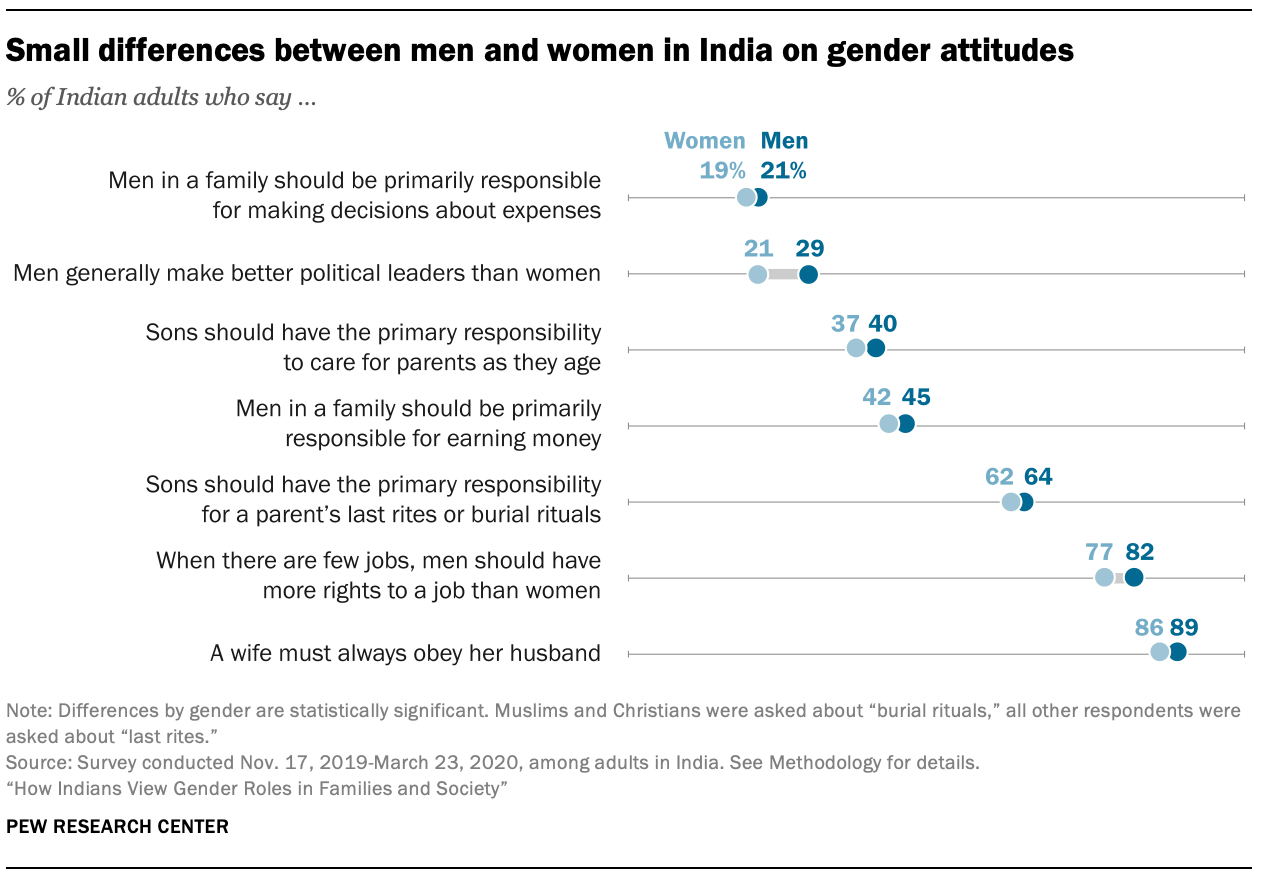
Equally, older Indians (ages 35 and older) are marginally extra probably than youthful adults to carry conventional views on gender roles. Whereas 45% of Indians ages 35 and older say that males in a household ought to be primarily liable for incomes cash, 42% of these ages 18 to 34 agree.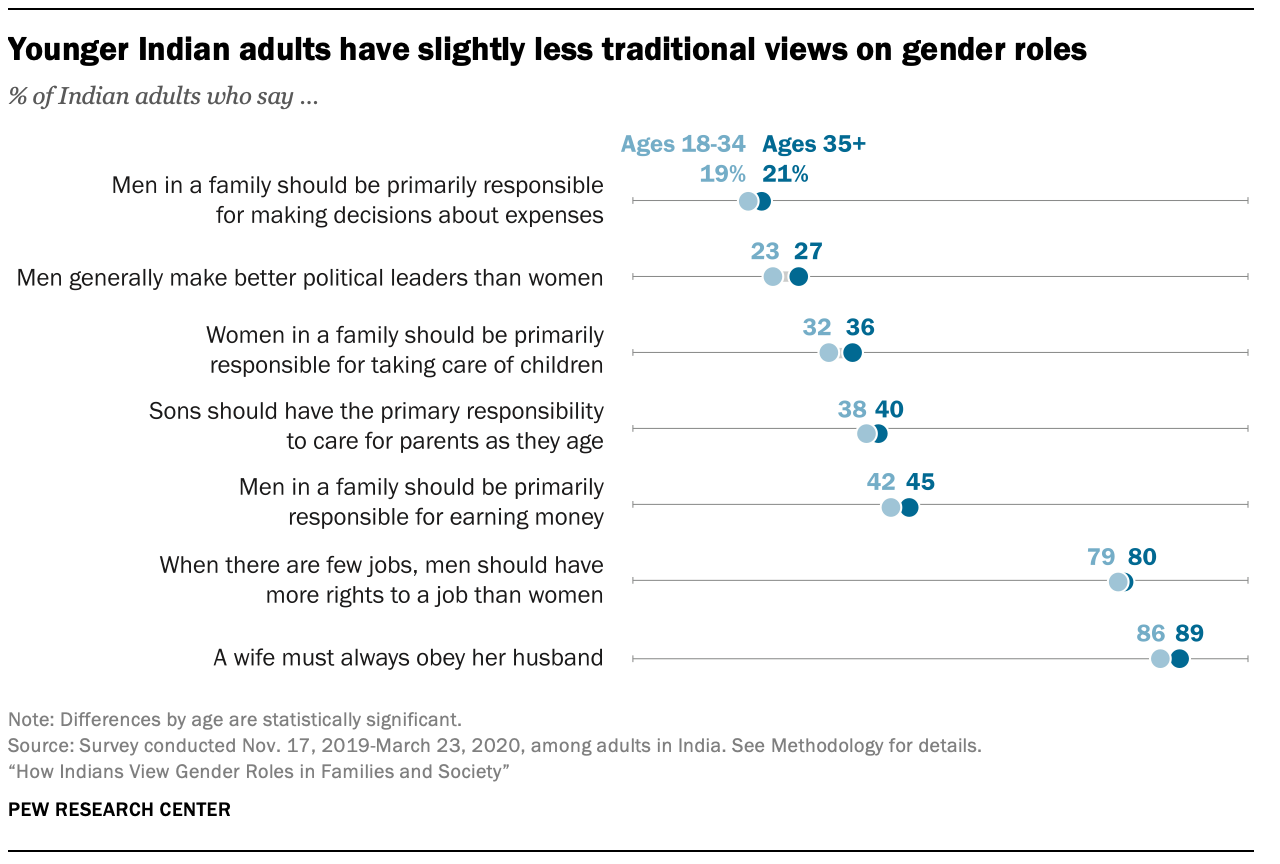
Even when taking a look at attitudes solely amongst Indian ladies, the variations between youthful and older adults are minimal, with older ladies barely extra probably than youthful ladies (ages 18 to 34) to carry conservative views on gender roles. For instance, 37% of older Indian ladies (ages 35 and older) suppose ladies in a household ought to be primarily liable for caring for kids, whereas a 3rd of youthful Indian ladies take this place.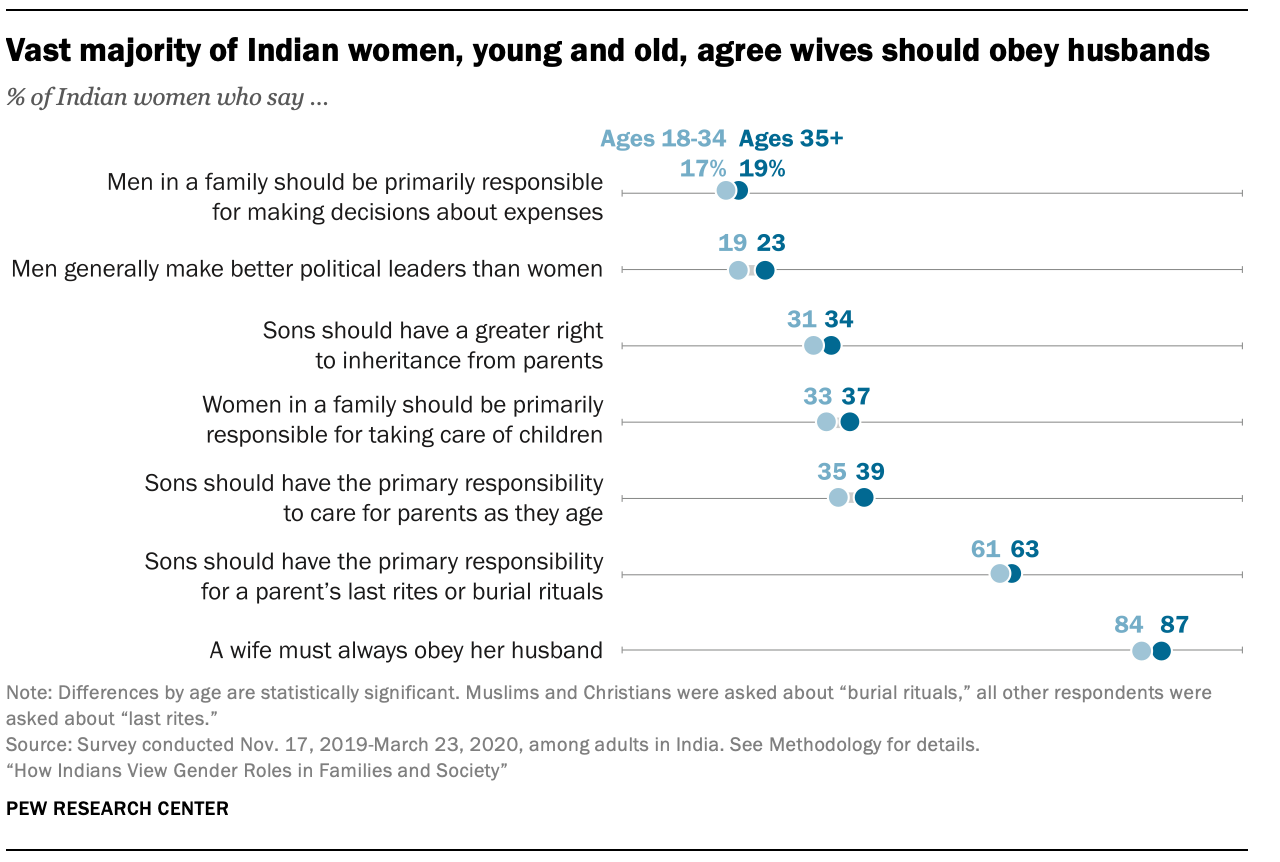
The overall consistency throughout age teams might recommend that Indian attitudes on household gender roles will not be altering very a lot over time. However a long-running survey exhibits that attitudes and behaviors on gender roles seem to have turn into extra egalitarian for the reason that finish of the twentieth century, with maybe the largest modifications within the early 2000s.
India’s National Family Health Survey (NFHS) has been performed 5 occasions, with the primary occurring roughly three a long time in the past. Usually, ladies ages 15 to 49 and males ages 15 to 54 in chosen households are eligible to be interviewed.6 By comparability, all Indian adults (ages 18 and older) had been eligible to be included within the Pew Analysis Middle survey. Variations in sampling and query wording make it troublesome to match the 2 surveys immediately. Nonetheless, NFHS surveys are helpful in analyzing knowledge over time.
Between the survey’s second (1998-99) and third (2005-06) rounds of knowledge assortment, a number of measures confirmed a transfer away from conventional attitudes. For instance, whereas 31% of married ladies underneath age 50 who had been incomes cash in 1998 and 1999 stated that their husband was primarily deciding tips on how to use the cash the spouse earned, that quantity halved (15%) by 2005 and 2006.
Between the survey’s third (2005-06) and fourth (2015-16) rounds, modifications have been extra modest, although nonetheless with a slight tendency towards much less conservative views. Over that decade, as an example, the share of married males underneath age 50 who stated husbands ought to have the better say in deciding about visits to a spouse’s household or family declined barely, from 26% to 21%.7 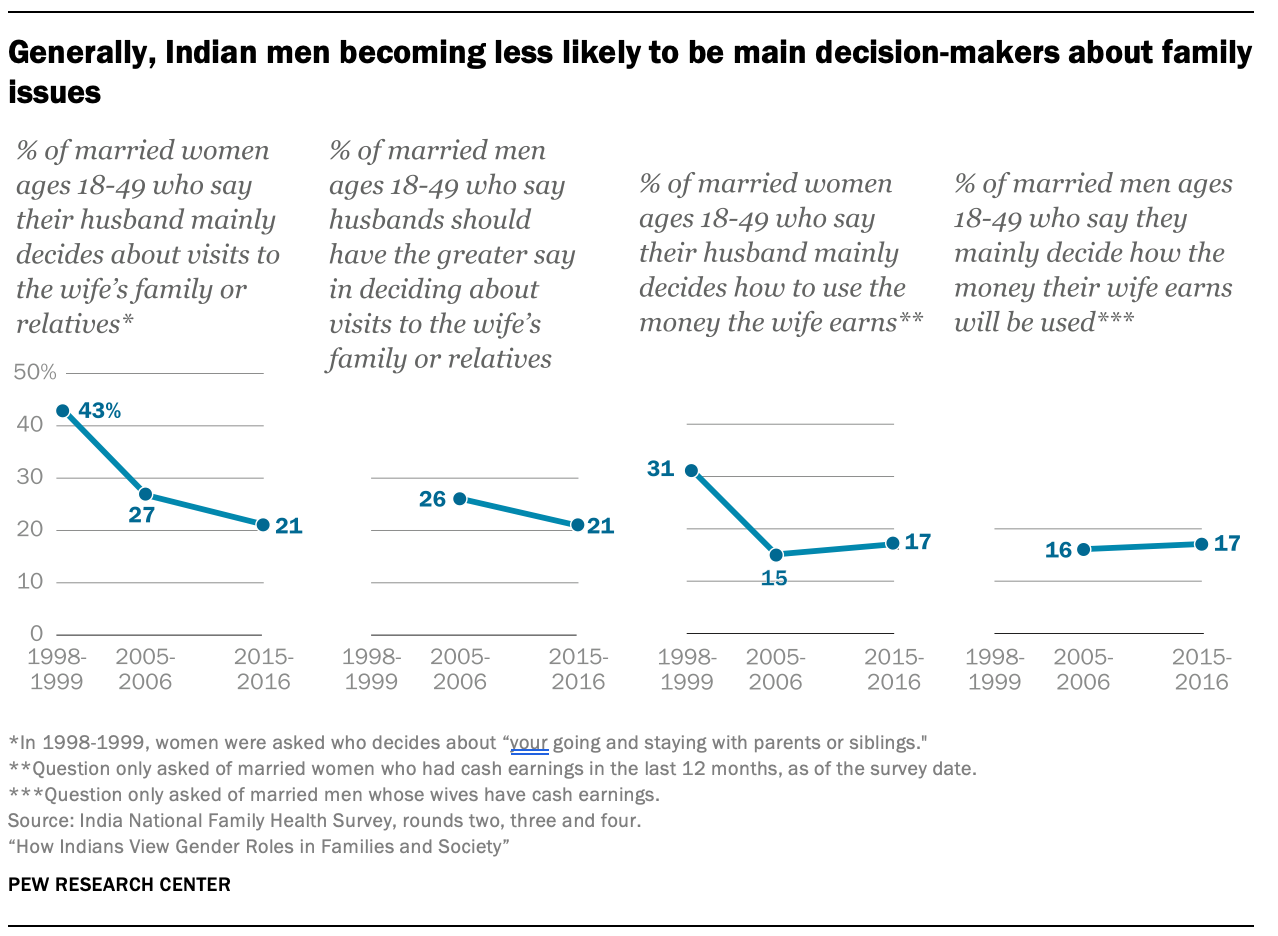
Girls in India’s Southern states typically have higher socioeconomic outcomes, on common, than these in different elements of the nation, significantly when put next with states within the Northern Hindi Belt. As an illustration, Southern ladies are usually more highly educated and to live longer. This North-South divide is commonly discussed in academic literature.
However Southern attitudes towards gender roles aren’t essentially extra egalitarian. Whereas Indians within the South are much less probably than these within the Hindi Belt to say, for instance, {that a} spouse should at all times obey her husband (75% vs. 94%), Southern adults are extra more likely to say that males in households ought to be liable for making choices about bills (25% vs. 13%) and that ladies ought to be primarily liable for caring for youngsters (44% vs. 30%).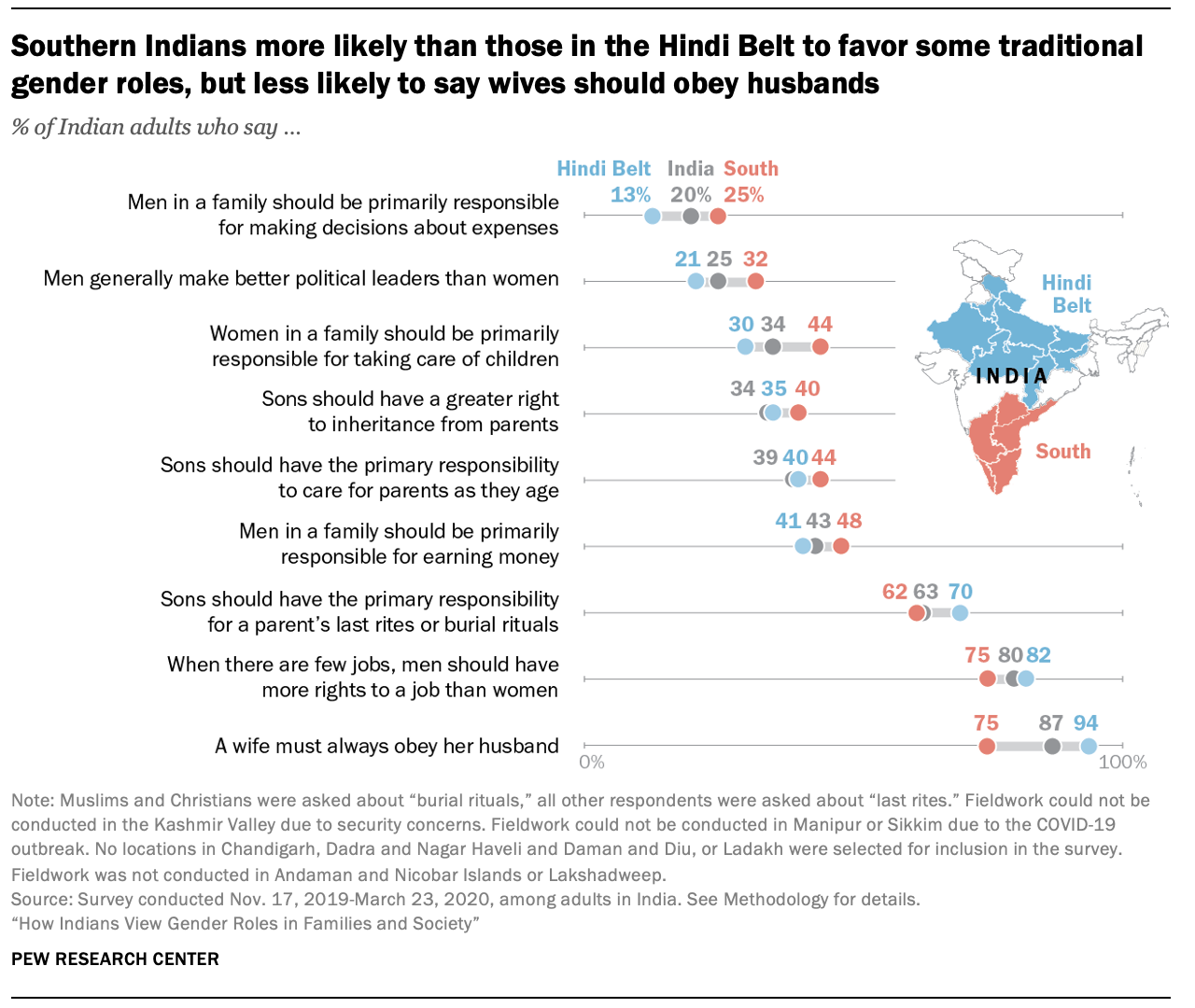
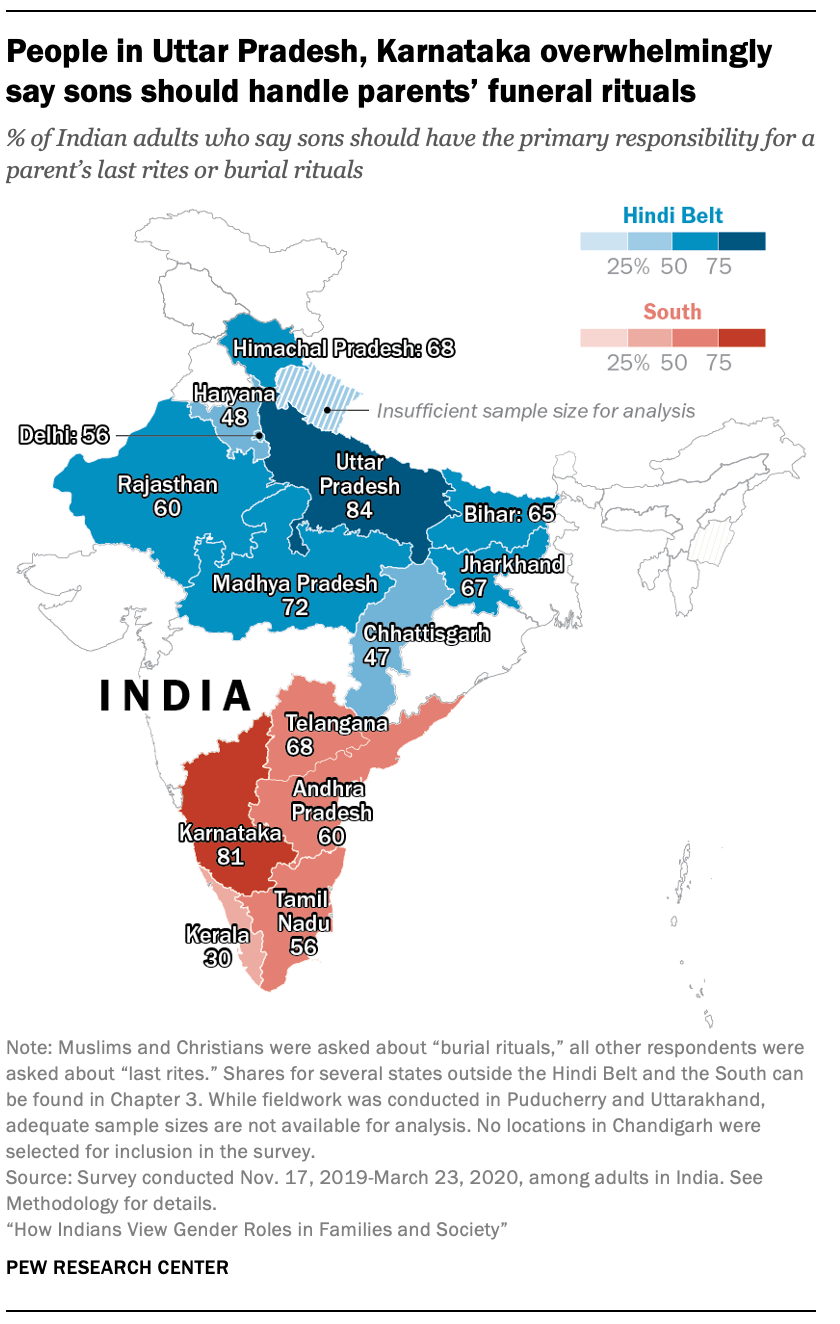 These regional analyses, although, masks important variation inside areas. Within the South, folks in Karnataka and Andhra Pradesh usually categorical extra conventional views than these in Kerala: 81% of Karnataka’s residents and 60% in Andhra Pradesh suppose sons ought to be liable for a mother or father’s final rites, whereas simply 30% of Keralites say the identical. In the meantime, attitudes towards gender roles in Tamil Nadu and Telangana are inclined to range quite a bit primarily based on the problem; for instance, Tamilians are among the many least more likely to say {that a} spouse should at all times obey her husband, however the state additionally has the very best share of people that say ladies ought to be primarily liable for caring for youngsters.
These regional analyses, although, masks important variation inside areas. Within the South, folks in Karnataka and Andhra Pradesh usually categorical extra conventional views than these in Kerala: 81% of Karnataka’s residents and 60% in Andhra Pradesh suppose sons ought to be liable for a mother or father’s final rites, whereas simply 30% of Keralites say the identical. In the meantime, attitudes towards gender roles in Tamil Nadu and Telangana are inclined to range quite a bit primarily based on the problem; for instance, Tamilians are among the many least more likely to say {that a} spouse should at all times obey her husband, however the state additionally has the very best share of people that say ladies ought to be primarily liable for caring for youngsters.
The Hindi Belt additionally has giant variations between states on gender roles. For instance, Uttar Pradesh is usually among the many most conservative states, whereas the Nationwide Capital Territory of Delhi is constantly on the different finish of spectrum. For full state-level particulars on these questions, see Chapter 3.
Previous reporting from this survey largely used membership in India’s six zonal councils to outline areas. On this report, nevertheless, it makes extra sense to investigate on the state degree as a result of huge variations amongst states inside the identical zone.
This report does, although, describe variations between two generally mentioned areas: the Hindi Belt and the South. Whereas completely different definitions exist, a broad definition of the Hindi Belt consists of the next 11 states and union territories, situated within the Northern a part of the nation: Bihar, Chandigarh, Chhattisgarh, Delhi, Haryana, Himachal Pradesh, Jharkhand, Madhya Pradesh, Rajasthan, Uttar Pradesh and Uttarakhand.
The South consists of the next six states and union territories: Andhra Pradesh, Karnataka, Kerala, Puducherry, Tamil Nadu and Telangana.
Despite the fact that the surveys embrace completely different questions and have completely different pattern compositions, NFHS surveys broadly present related patterns to the Middle’s latest survey: Southern attitudes and behaviors usually are similar to, or much more conventional than, these within the Hindi Belt, and states inside each areas are numerous in how conventional gender roles are thought-about.
For instance, in probably the most lately launched NFHS knowledge, a couple of third of males in Southern states (34%) say husbands ought to have a better say than wives when making main family purchases, in contrast with roughly 1 / 4 in Hindi Belt states (27%).8
On this matter, within-region variation is stark within the Hindi Belt. Whereas 37% of residents in Chandigarh suppose husbands ought to have extra say than wives in main purchases, simply 13% in Himachal Pradesh supply this opinion.9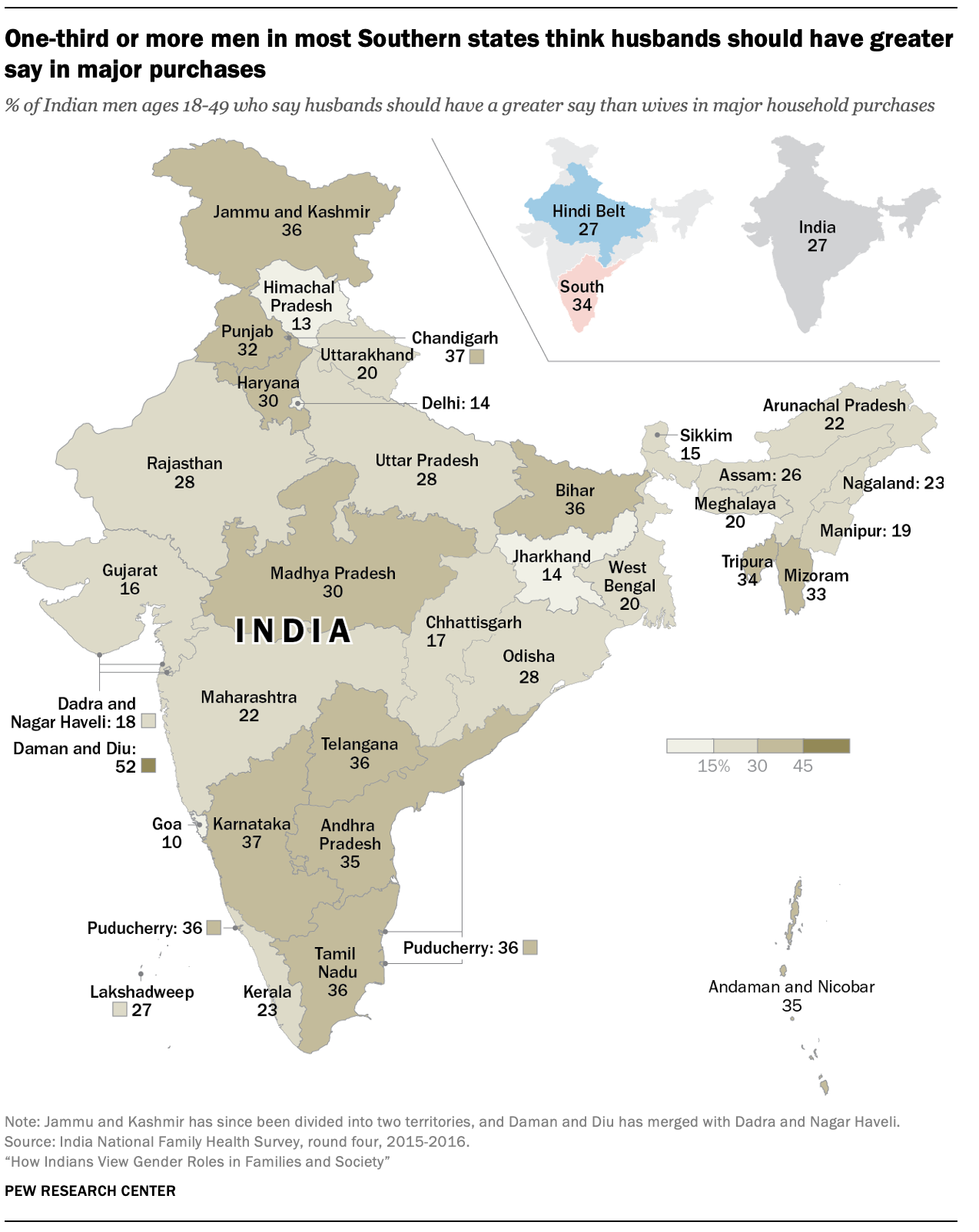
Despatched weekly on Wednesday
1615 L St. NW, Suite 800
Washington, DC 20036
USA
(+1) 202-419-4300 | Main
(+1) 202-857-8562 | Fax
(+1) 202-419-4372 | Media Inquiries
About Pew Research Center Pew Analysis Middle is a nonpartisan truth tank that informs the general public in regards to the points, attitudes and developments shaping the world. It conducts public opinion polling, demographic analysis, media content material evaluation and different empirical social science analysis. Pew Analysis Middle doesn’t take coverage positions. It’s a subsidiary of The Pew Charitable Trusts.







